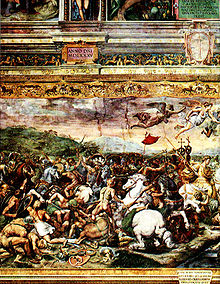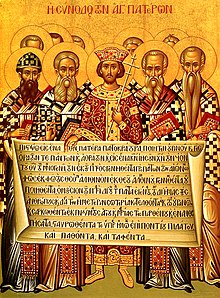Constantinian shift

Constantinian shiftis used by sometheologiansandhistorians of antiquityto describe the political and theological changes that took place during the4th-centuryunder the leadership of EmperorConstantine the Great.Rodney Clappclaims that the shift or change started in the year 200.[1]The term was popularized by theMennonitetheologianJohn H. Yoder.[2]He claims that the change was not just freedom from persecution but an alliance between theStateand the Church that led to a kind ofCaesaropapism.The claim that there ever was a Constantinian shift has been disputed;Peter Leithartargues that there was a "brief, ambiguous 'Constantinian moment' in the fourth century", but that there was "no permanent, epochal 'Constantinian shift'".[3]
The Shift
[edit]
Constantine the Great(reigned 306–337) adoptedChristianityas his system of belief after his victory at theBattle of Milvian Bridgein 312.[4][5][6]The following year, 313, he issued theEdict of Milanwith his eastern colleague,Licinius.The edict legalised Christianity alongside other religions in theRoman Empire. In 325 theFirst Council of Nicaeasignalled consolidation of Christianity under an orthodoxy endorsed by Constantine. While this did not make other Christian groups outside the adopted definition illegal, dissentingArian bishopswere initially exiled. But Constantine reinstatedAriusjust before the heresiarch died in 336 and exiled the OrthodoxAthanasius of Alexandriafrom 335 to 337. In 380 EmperorTheodosius Imade Christianity the Roman Empire'sofficial religion(seeState church of the Roman Empire). In 392 Theodosius passed legislation prohibiting allpagancultic worship.[7]
During the 4th century, however, there was no real unity between church and state: in the course of theArian controversy,Arianor semi-Arian emperors exiled leading Trinitarian bishops, such asAthanasius(335, 339, 356, 362, 365),Hilary of Poitiers(356), andGregory of Nyssa(374[8]); just as leading Arian andAnomoeantheologians such asAëtius(fl. 350) also suffered exile.
Towards the end of the century, BishopAmbrose of Milanmade the powerful EmperorTheodosius I(reigned 379–395) do penance for several months after themassacre of Thessalonica(390) before admitting him again to theEucharist.On the other hand, only a few years later,Chrysostom,who as bishop ofConstantinoplecriticized the excesses of the royal court, was eventually banished (403) and died (407) while traveling to his place of exile.
Theological implications
[edit]| Separation of church and state in the history of the Catholic Church |
|---|
Critics of state-aligned Christianity often point to the ascension of Constantine as the beginning ofCaesaropapism:according to this critique, the official Christianity of the Roman state rapidly became a religious and metaphysical justification for the existence, exercise, and expansion of worldly political power, ultimately facilitating earthly Christian empire both for Rome and its successors acrossChristendom.Similar criticisms are levied byChristian anarchists,who claim that the Constantinian shift triggered theGreat Apostasyby transforming the religion into a means for preserving the ruling elite's power and justifying violence.[9]
Augustine of Hippo,who originally had rejected violence in religious matters, later justified it theologically against those he considered heretics, such as theDonatists,who themselves violently harassed their opponents.[10]Before him,Athanasiusbelieved that violence was justified in weeding out heresies that could damn all future Christians.[11]He felt that any means was justified in repressingArianbelief.[12]In 385,Priscillian,a bishop in Spain, was the first Christian to be executed for heresy, though the most prominent church leaders rejected this verdict.
Theologians critical of the Constantinian shift also see it as the point at which membership in the Christian church became associated with a social concept of citizenship, rather than reflecting one's internal decisions and feelings. American theologianStanley Hauerwasnotes the shift as forming part of the foundation for the contemporary American conception of Christianity, one that is closely associated withpatriotismandcivil religion.[citation needed]
See also
[edit]References
[edit]- ^Clapp, Rodney (1996).A Peculiar People.InterVarsity Press. p.23.
What might be called the Constantinian shift began around the year 200 and took more than two hundred years to grow and unfold to full bloom.
- ^e.g. inYoder, John H. (1996). "Is There Such a Thing as Being Ready for Another Millennium?". In Miroslav Volf; Carmen Krieg; Thomas Kucharz (eds.).The Future of Theology: Essays in Honor of Jurgen Moltmann.Eerdmanns. p. 65.
The most impressive transitory change underlying our common experience, one that some thought was a permanent lunge forward in salvation history, was the so-called Constantinian shift.
- ^Peter Leithart,Defending Constantine: The Twilight of an Empire and the Dawn of Christendom,p 287.
- ^Lactantius XLIV, 5
- ^Eusebius XXVII–XXXII
- ^Brown 2006, 60.
- ^Theodosian Code, XVI.1.2
- ^Schaff, Philip,ed. (2007) [1893].Nicene and Post-Nicene Fathers.Second. Vol. V. Gregory of Nyssa. Cosimo. p. vii.ISBN978-1-60206516-1.Retrieved2012-12-16.
374[:] Gregory is exiled under Valens
- ^Christoyannopoulos, Alexandre(2010)."Christian Anarchism: A Revolutionary Reading of the Bible".New Perspectives on Anarchism.Lanham, Maryland:Le xing ton Books.pp. 149–168.
- ^"The Donatists and Their Relation to Church and State « Biographia Evangelica".Archived fromthe originalon 2019-12-27.Retrieved2019-06-04.
- ^Olson, 172
- ^Barnes, 230.
Further reading
[edit]- Timothy Barnes,Constantine and Eusebius,1981
- Theodosian Code,Henry Bettenson,ed., Documents of the Christian Church, (London: Oxford University Press, 1943), p. 31. see:http:// fordham.edu/halsall/source/theodcodeXVI.htmlArchived2007-02-27 at theWayback Machine
- Peter Brown,The Rise of Western Christendom(Oxford: Blackwell Publishing, 2003),60.
- James Bulloch,From Pilate to Constantine,1981
- Eusebius of Caesarea,Life of Constantine,Library of Nicene and Post Nicene Fathers, 2nd series (New York: Christian Literature Co., 1990), Vol I, 489–91. see:http:// fordham.edu/halsall/source/conv-const.html
- Alistair Kee,Constantine Versus Christ,1982
- Lactantius, Lucius Caecilius Firmianus,On the manner in which the persecutors died(English translation ofDe Mortibus Persecutorum) see:http:// intratext /IXT/ENG0296/_P18.HTM
- Ramsay MacMullen,Christianising the Roman Empire,1984
- Roger E. Olson,The Story of Christian Theology,1999
External links
[edit]- Social Constantinianism- anEvangelicalperspective on the Constantinian shift
- Basil's Struggle with Arianism after Constantine.
- Timeline of Fourth-Century Roman Imperial Laws showing the Constantinian shift
